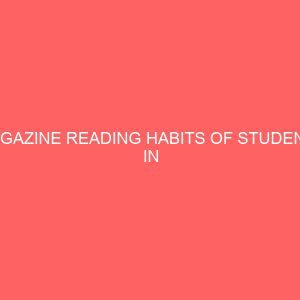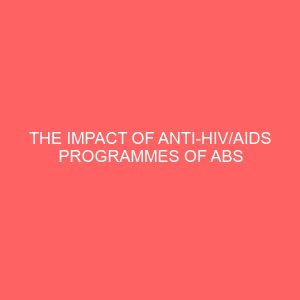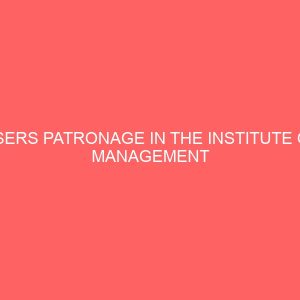Description
CHAPTER ONE
1.0 INTRODUCTION
Magazine is a package of news events written in analytical form. Because of the periodic nature of the magazine, information on day to day events are not emphasized, instead it concentrates on giving in0depth, focus, perspective, bearing explanation or interpretation of news, since it has more time and considers pace to dig or investigate and also research into issues and situations.
The magazine in any society occupies an indispensable position. The magazine has been described as a daily historic document. This is because it chronicles every significant issue or event happening within society. The magazine serves to check such exercises its report, of issues of the day. Thus, it is the most important source of reference for scholars, historians, sociologists, politicians and so on.
Magazine is a big industry. It is capital intensive and expensive. Its customer ship transverses its area of circulation, and it often loyal. From its advertises who ensure heavy revenue to the buyer who does same, it is all hopes of good income.
As a big industry, the magazine ensures employment opportunities, fulfills its obligations to its employee by paying salaries and Emoluments, helps in ensuring community development through provision of social and welfare amenities.
The magazine has provided excellent facilities for product promotion and advertisement. This is a most undeniable contribution ot product development. Advertisements of goods and services give us information on the merits and demerits of that product and help decide what is good for the individual. Apart form this, adverts helps develop healthy rivalry between manufacturers of similar goods.
Magazine has a vital importance in discovering areas of societal structural decay, lack of amenities like potable water, light, roads, medical and paramedical facilities. The magazine must then address these issues accordingly with a purpose of ameliorating the situation.
One things that will be a recurring decimal is that people have different views of reading magazines. That is to say, what is perceived is according to the perception of the perceiver which is another way of saying that people have reasons for choosing different media based on what they want to get form those media.
As Awodiya (1974) points out that most people read news magazines because of the durability of information gathered from them. Magazine offers the opportunity to read, re-read, discuss and debate on the information.
Macdugall (1984) believes that magazines are read by some people because hey take the readers behind the events of the days actions, relate the news to the readers, own frame work and experience, make sense out of the facts; put factual news in perspective, add meaning to the news and help point-out the significance of current events.
The above assumptions have made the researcher to find-out the magazine reading habits of students in the tertiary institution. This is the area of special interest in this project.
1.1 BACKGROUND OF THE STUDY
In Nigeria, the very first magazine was the SPEAR AND DRUM, but the very serious attempt to publish a magazine started with publication of Nigerian Magazine in 1963.
One major characteristic of magazine in Nigeria at that time was the very transience nature of their existence. For three years after Nigerian magazine emerged, West African reared its head for a short span of 12 months (January-December, 1966). A number of factors accoutered for West African demise, but paramount among them were finance and ravaging Nigerian Biafra Civil War at that time.
However, this magazine, after some serious re-organization four years after the war, resumed publication that lasted for eight years. That was the period between 1974 and 1982.
The plight of West Africa has been very similar to that of other Nigerian Magazines. Many of them often are off the streets, the very month they started.
Given this transience Magazine, there is no gain saying the fact that Nigerian magazine readers should now have a more steady Nigerian periodicals that are serious, objective, analytical, purposeful and enduring.
At least, one that could compete favourably with Newsketch, time etc. it was with this five need in Nigerian readers that the birth of Newswatch was created with such riotous joy and since then, some magazines in this same pedestal have emerged, these are This week African Guardian etc.
Since this study is focused towards finding out magazine reading habits of students in the institutions of higher learning, one question may manifest, what use of Nigerian under graduates make of the information gathered form the magazines?
In the study by Wilbur Schramm and David White in (1949:106), it was discovered that readers with low education attainment, sensational news and pictorials materials. They also found out that those at the top of education curve tend to use it less mainly for information and public affair.
Again, a similar study which proceeded that of Wilbur Schramm and David W, which was conducted by other communication experts, Paul Lazarfled and Patricia Kendall (1948:439) also discovered that readership of magazines increases with higher level and decline as level of education decline.
In the same note, Obiajulu Emejulu (2004), maintained other materials are routinely adapted to classroom and other educational purpose by resourceful teachers. This makes for diversity, creativity and fun in the classroom.
Our interest in students of tertiary institutions is not without convincing reasons. Studies have reverted that high propensity to read magazine is contingent on a persons educational background. We therefore, picked on Nigerian undergraduates believing that they constitute one of the higher educational groups in the country. This is based on the studies we have cited.
1.2 STATEMENT OF PROBLEMS
1. Magazine credibility is likely to determine high readership among Nigerian undergraduates.
2. The need for information form magazine may positively or negatively determine high readership among Nigerian undergraduates.
3. The value of magazine may determine its vital source of information to Nigerian undergraduates.
4. Gender determines high readership of magazine among students in Nigeria.
5. year of study influences the high readership of magazine among students in high institutions in Nigeria.
1.3 PURPOSE OF THE STUDY
The research is aimed at:
1. To find out the rate at which students in Nigeria higher institutions read magazine.
2. To examine the nature of news stories or features and articles they read and why they read them.
3. To examine to what extent information gathered form magazine is made useful by students of higher learning.
4. To obtain scientific information regarding the habits of magazine readership of Nigeria undergraduates.
1.4 SIGNIFICANCE OF THE STUDY
An effective magazine editor should have foresight to always meet its target audience. This study on media pattern in Nigeria has not been extensive as we think would have been adequate, instead an impediment to dissemination of information. It is of this reason I was motivated to carry out this research. This study will enable the editors to give insight into what their readers want to read. Again, this study is very important because it will help both editors and the media in general and for scholarship in communication.
1.5 SCOPE OF THE STUDY
The magazine reading habit is fairly wide in scope. However, in this study the researcher will only focus on the magazine reading habit of students in tertiary institution, using Nnamdi Azikiwe University, Awka as a case study.
1.6 RESEARCH QUESTIONS
The following research questions are to be used.
1. Does magazine credibility determine high readership among students in the higher level in Nigeria?
2. Does the need for information determine high readership by Nigerian undergraduates?
3. Does vital source of information determine high readership of magazine by Nigerian students?
4. Does gender influence high readership of magazine among students in Nigeria?
5. Does the year of study influence the high readership of magazine among students in high institutions in Nigeria?
1.7 LIMITATION OF THE SUTDY
This research work was immensely constrained by the time scheduled based on other school engagements like magazine production and my final semester examination.
On a similar note, not all my respondents returned their questionnaires as at the time needed. So, many of the respondents shy away form the questionnaires.
1.8 DEFINITION OF TERMS
CONCEPTUAL DEFINITION
1. Institution: A large important organization that has a particular purpose.
2. Magazine: Type of large book printed with a paper cover that you can buy weekly or monthly containing articles.
3. Periodical: A magazine published every week, month especially one that is concerned with an academic subject.
4. Audience: Group of people who gather to watch or listen to something like play, concert etc.
Operational Definition
1. Institution: This is the place where the research is carried out or the school I find my audience.
2. Magazine: Analytical book for the audience that disseminates day-to-day information.
3. Periodical: Publication intended for general audience at a given interval, weekly or monthly.








